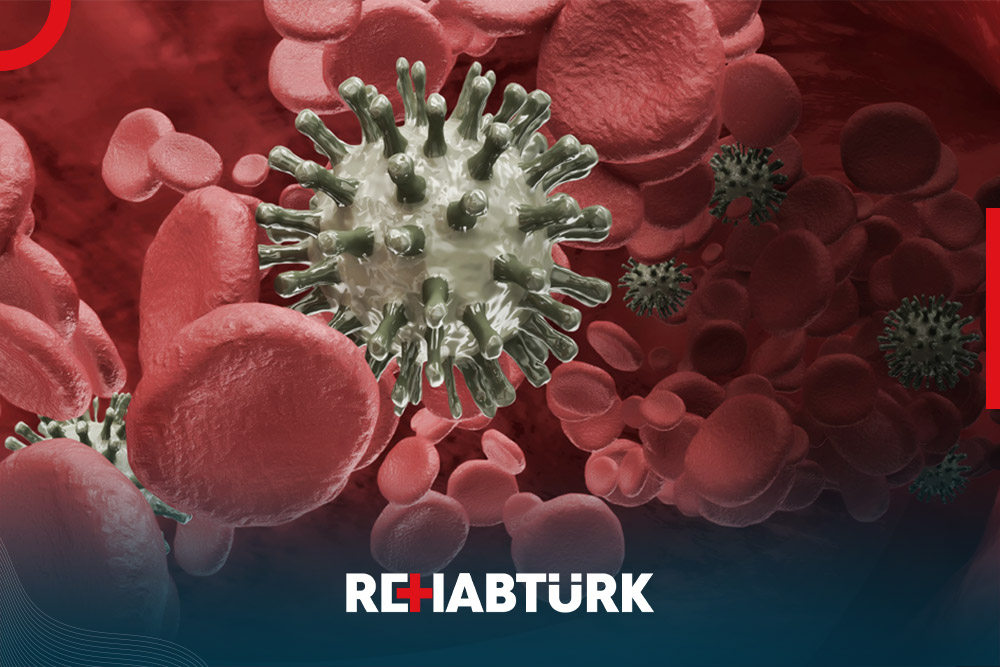Leukemia treatment in Türkiye
Leukemia treatment
What is leukemia?
There are several classes of blood cells in the body, including red blood cells ( erythrocytes ), white blood cells ( leukocytes ), and some platelets. Leukemia is cancer of the white blood cells.
White blood cells are a vital part of the immune system because they protect the body from invading bacteria, viruses, and fungi. It also protects the body from abnormal cells and other foreign substances. When leukemia occurs, the white blood cells do not function as effectively as usual, dividing very quickly and crowding out other normal, healthy cells.
White blood cell production centers are often in the bone marrow, in addition to certain types in the lymph nodes, spleen, and thymus gland. .
risk factors for leukemia

Its main causes are not known, however several factors that may increase the risk of developing leukemia have been identified and include the following
- Having a genetic condition of leukemia
- Smoking, which increases the risk of acute myeloid leukemia
- Genetic disorders such as Down syndrome
- Blood disorders, such as myelodysplastic syndrome, which is sometimes called
- Previous cancer treatment with chemotherapy or radiation
- Exposure to high levels of radiation
- Exposure to chemicals such as benzene
Types of leukemia
The onset of cancer can be acute (sudden) or chronic (slow) and affects a change in the color of the blood. Cancer cells multiply rapidly and turn the blood into a chronic white color. Sometimes the disease develops slowly and early symptoms may be very mild.
disease classifications
Leukemia is classified according to the type of cell affected. Those that affect myeloid cells are called myelogenous leukemia. Myeloid cells are immature blood cells that usually turn into granular or acute cells. Those that affect lymphocytes are called lymphocytic leukemia.
There are four main types of leukemia
AML Acute myelogenous leukemia
It affects children and adults, and this is the most common form in the world, and the five-year survival rate is 26.9%.
ALL acute lymphoblastic leukemia
It mostly affects children and the five-year survival rate is 68.2%
CML chronic myelogenous leukemia
It mostly affects adults and the five-year survival rate is 66.9%
CLL Chronic lymphocytic leukemia
It is most likely to affect people over the age of 55 and rarely appears in children. The five-year survival rate is 83.2%. When infected, the affected lymphoma cells are visible only under a microscope.
What are the symptoms of leukemia
- Excessive sweating, especially at night
- Excessive fatigue and weakness
- Unintentional weight loss
- Bone pain
- Painless swollen lymph nodes (especially in the neck and armpits)
- Enlarged liver or spleen
- Red spots on the skin called petechiae
- Bleeding and bruising easily
- fever or chills;
- frequent infections
In addition, leukemia can also cause other symptoms in organs that have been infiltrated or affected by cancer cells, for example, if cancer spreads to the central nervous system, it can cause headaches, nausea, vomiting, confusion, loss of muscle control, seizures, and it can also spread to other parts of the body. , including
- the lungs
- Digestive
- the heart
- kidneys
- testicles
How is leukemia diagnosed?
Leukemia may be suspected if there are certain risk factors or worrisome symptoms and it is done by the doctor after conducting a complete physical examination for you, but sometimes a physical diagnosis is not enough, then doctors will use blood tests, biopsies, and x-rays to make the diagnosis.
the exams
There are a number of different tests that can be done to diagnose leukemia, including a complete blood count (CBC), count of red blood cells, white blood cells, and platelets. Biopsies of bone marrow or lymph nodes may be taken to look for evidence of leukemia. These small samples can determine the type of leukemia and its growth rate. Biopsies of other organs such as the liver and spleen show whether the cancer has spread or not.
Therapeutic steps
When diagnosing a case of infection, the patient is instructed to take preventive and therapeutic measures by the doctor, according to the type of cancer and the extent of its spread in the body.
Assessment of disease progression
A number of tests can be used to assess disease progression
- A flow cytometric assay that determines the growth rate of cancer cells
- A liver function test to see if leukemia cells are affecting or invading the liver
- A “lumbar puncture” is performed by inserting a thin needle between the vertebrae in the lower back. This test allows the doctor to collect a sample of cerebrospinal fluid and determine whether cancer has spread to the central nervous system.
- Also, imaging tests such as X-rays, ultrasounds, and CT scans are used by doctors to look for any damage to other organs caused by leukemia.
leukemia treatment ( treatment)
Treatment is usually done by hematologists and oncologists. They are doctors who specialize in blood diseases and cancer. Treatment depends on the type and stage of cancer. Some forms of leukemia grow slowly and do not need immediate treatment. However, leukemia treatment usually involves several procedures, including:
Chemotherapy.
Treatment uses medicines to kill leukemia cells. This is done depending on the type of cancer. One drug or a combination of different drugs can be taken according to the diagnosis of the condition by the doctor.
Radiation therapy.
It uses high-energy radiation to destroy infected leukemia cells and prevent their growth. Radiation therapy can be applied to a specific area or to the entire body.
Stem cell transplant .
By replacing diseased bone marrow with healthy bone marrow, either from the patient’s own (called an autologous transplant) or from a donor (called an allogeneic stem cell transplant ), this procedure is also called a bone marrow transplant.
Biological or immunotherapy .
It uses therapies that help the immune system to recognize and attack cancer cells, and in some cases it uses targeted therapy through drugs to take advantage of weaknesses in cancer cells. For example, there is a targeted drug that is commonly used against chronic myeloid leukemia.
Long term side effects
Long-term side effects for people with leukemia depend on the type of cancer they have and the stage at diagnosis. The sooner the diagnosis is made, the sooner it is treated and the chance of recovery is greater. Some factors such as advanced age, blood disorders and chromosomal mutations can negatively affect and exacerbate the effects of the disease and the rate of recovery from it.
How can I book for leukemia treatment in Türkiye?

- Free medical support on the phone: You will have a dedicated representative for your health condition who is always ready to answer your questions.
- Free consultation with a specialist doctor: Your medical representative will consult with a number of doctors and hospitals to find the best possible treatments.
- Free travel visa arrangement: We will contact the embassy in your country to assist you in obtaining a visa to visit Türkiye.
- Free itinerary planning: We will create a schedule for your medical trip to Türkiye.
- Free translation of documents and reports: We will translate medical documents and reports into Turkish on your behalf.
- Free support and monitoring: We will monitor the stages of treatment and be by your side every step of the way.
- Free instant translation: We will be with you during the treatment stages to provide translation between you and the medical team.
- Free accommodation and transportation coordination: We will book accommodation for you and your companions in Türkiye, along with transportation services.
Contact REHABTÜRK doctors for more information about the procedure and to evaluate your medical condition.
